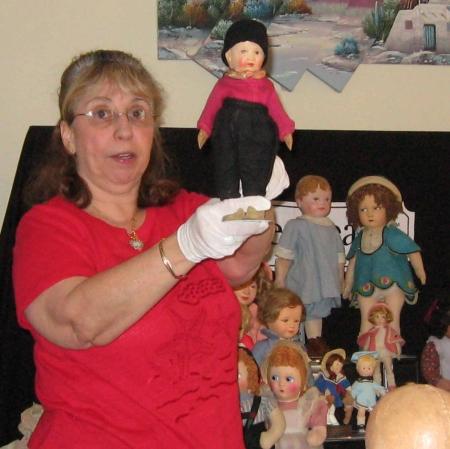
Retired teacher Loretta Nardone is in demand at conferences that celebrate dolls and their artists.
Loretta Nardone loved dolls as a child, as many youngsters do, but Nardone never outgrew that love. A retired elementary school teacher, Nardone took her collection of dolls from around the world into her classrooms at PS 145 in Brooklyn and at PS 41 on Staten Island, where she incorporated them into lessons about different cultures and traditions.
“Every doll has a story,” Nardone said. To engage her students, “I had the younger boys and girls make corn husk dolls. Later, when I taught 4th- and 5th-graders, I used dolls for a discussion about body image.”
Nardone taught UFT workshops about using dolls in the classroom, and she presented a program on the topic at the United Nations. During her 31-year teaching career, she worked with doll collector groups and wrote articles for doll magazines. When Nardone retired in 2006, the dolls were waiting for her like old friends who never lost touch.
“I worked my way up the ladder at the United Federation of Doll Clubs,” said Nardone, who now lives in Florida. She started as secretary/treasurer in 2011, and was president of the federation from 2017 to 2019. Nardone still pitches in: she edited the group’s 2021 convention journal and is the advertising manager for Doll News, the federation’s quarterly magazine. She wrote a book about Zuni beaded dolls, representing Native American folk art, in 2009 and continues to write articles about dolls of all kinds.
Nardone can tell you about the doll collector who was a spy during World War II. “Velvalee Dickinson had a mail-order doll business in New York City and passed secrets to the Japanese in her doll shipments,” she said. And there was Baronne Sandra Belling, an aristocrat who fled Russia after the revolution and lived in Syria. “She taught women how to make dolls that reflected their heritage,” Nardone said. Teaching women to make dolls could be life-changing. “There were a lot of missionary women in China who taught girls to make dolls to get out of the brothels,” she explained.
Nardone is in demand at conferences that celebrate dolls and their artists as well as the vintage and antique dolls found in museums.
Nardone continues to use dolls as a gateway to learning about people around the world, their cultures and their traditions. She created a website, DollsAroundtheWorld.com, which she calls her own “virtual museum,” so she could share her collection and research with others. Her dolls — from the Americas, Asia, Africa and Europe — were all made in the countries they represent and once could be bought as souvenirs in their country of origin or purchased by mail order.
In a section on the website about dolls from the Middle East, there is a doll wearing a tantur, a conical headdress worn by Lebanese women, and a doll from Israel that is dressed for farming on the kibbutz. Some dolls are dressed in silk, others in cotton and other fabrics.
“A doll reflects the history and mores of society,” Nardone said. “It provides insights into others and ourselves and leads to a greater understanding and tolerance of diverse cultures. Dolls reflect our humanity.”